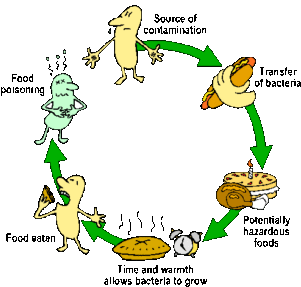Introduction
The vomiting, diarrhea, fever, abdominal cramps and all around bad feelings you may get with food poisoning is extremely unpleasant. We’ve previously discussed preventive measures you can take to minimize your risks, but you should also want to know what measures to take in the event you actually develop food poisoning. Of course, with over 250 different illnesses related to various forms of food poisoning, there’s a wide variety of treatment, some of which means to treat the specific disease (and its cause) and others that only treat the symptoms.
The threat
I always tell patients that although the vomiting and diarrhea are dramatic nuisance symptoms, the real concern is the risk of dehydration from these fluid losses. Given the body is approximately two-thirds water, altering that balance can lead to disturbances of many of the body’s functions and increase the risk of more serious infections. Thus the key to treatment is staying ahead of fluid and electrolyte losses that occur. Perhaps you’re wondering “How can I do that if I’m vomiting?”
Here are five very important treatment principles for you to remember.
- First things first: if you have severe diarrhea, your favorite sports drink is not the cure. The composition of fluids and electrolytes in your stool is different from in your sweat, so these drinks don’t optimally replace your losses.
- I want you to become familiar with oral rehydration therapy/solution (ORT). It’s how most of the rest of the world first treats fluid losses from vomiting and diarrhea. You may have heard of Ceralyte, Oralyte or Pedialyte, all of which are examples. ORT represents the best possible fluid for you to take and is readily available without a prescription at your local pharmacy or grocery store.
- Here’s the deal with staying hydrated: you can’t hold a lot on your stomach. You need to dial back as much as possible so that you can tolerate something. That’s why you sip on chicken soup instead of steak when you’re sick. You’re likely to have more success keeping down teaspoons of fluid at a more frequent interval (say, every few minutes) than trying to chug a lot of fluid all at once.

- Preparations of bismuth subsalicylate (Pepto-Bismol is a common example) can reduce the duration and severity of simple diarrhea.
- If you have diarrhea and cramps with a fever or bloody stools, you should not take antidiarrheal medication without an evaluation by a physician. Even if they make you feel better, these medicines can make your food poisoning much worse.
Here’s one other point that you should understand as you’re going into your doctor’s office or the emergency room: don’t expect to receive an antibiotic to treat your vomiting and diarrhea. Most of these episodes are caused by viruses, which are self-limited and will resolve within two to three days. Furthermore, viruses don’t respond to antibiotics. In fact, efforts to use antibiotics in many of these cases only contribute to antibiotic resistance later on when you actually need them. Antibiotic resistance is discussed in detail in this Straight, No Chaser post.
When to Seek Help
Finally, here are symptoms that should prompt you to see your physician.
- Bloody stools
- Diarrhea lasting more than 3 days
- High fever (oral temperature over 101.4 F)
- Signs of dehydration, such as a decrease in urination, a dry mouth and throat, and dizziness with standing
- Vomiting with inability to keep down liquids
Follow us!
Ask your SMA expert consultant any questions you may have on this topic. Also, take the #72HoursChallenge, and join the community. Additionally, as a thank you, we’re offering you a complimentary 30-day membership at www.72hourslife.com. Just use the code #NoChaser, and yes, it’s ok if you share!
Order your copy of Dr. Sterling’s books There are 72 Hours in a Day: Using Efficiency to Better Enjoy Every Part of Your Life and The 72 Hours in a Day Workbook: The Journey to The 72 Hours Life in 72 Days at Amazon or at www.jeffreysterlingbooks.com. Another free benefit to our readers is introductory pricing with multiple orders and bundles!
Thanks for liking and following Straight, No Chaser! This public service provides a sample of http://www.SterlingMedicalAdvice.com (SMA) and 844-SMA-TALK. Likewise, please share our page with your friends on WordPress! Also like us on Facebook @ SterlingMedicalAdvice.com! Follow us on Twitter at @asksterlingmd.
Copyright © 2018 · Sterling Initiatives, LLC · Powered by WordPress

























